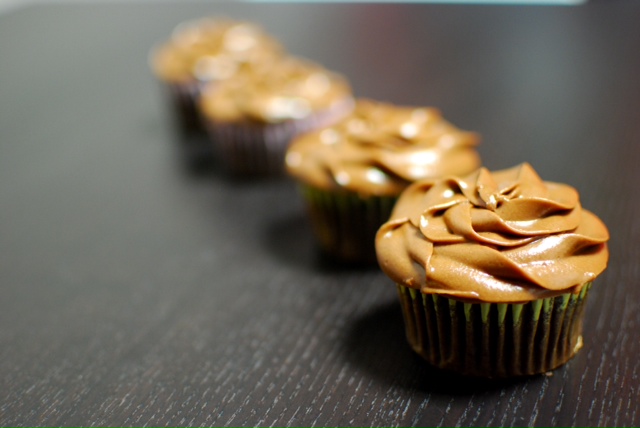For this experiment I used two different recipes: One for regular chocolate cupcakes and another one for vegan chocolate cupcakes.
Regular Chocolate Cupcakes
Ingredients:
2 cups all-purpose flour
3/4 cup Dutch-processed cocoa powder
2 tsp instant coffee
1 1/2 tsp baking soda
1/2 tsp salt
3/4 cup butter
1 3/4 cup sugar
4 large eggs
2 tsp vanilla extract
1 1/2 cups whole milk
The method for this recipe was pretty standard. Cream together the butter and the sugar. Add the eggs and vanilla and then gradually incorporate the dry ingredients. This batter was smooth and thick – typical cake mixture when baking cakes.
Vegan Chocolate Cupcakes
 Ingredients:
Ingredients:
3 cups all-purpose flour
1 3/4 cups superfine sugar
1 3/4 tsp baking soda
1/2 cup unsweetened cocoa powder
1/4 tsp salt
2 cups unsweetened soy milk
1/2 cup vegetable oil
1 1/2 Tbsp white vinegar
1 1/2 tsp vanilla extract
The method for this recipe was quite different. Since there is no butter (only vegetable oil) the recipe called for all the wet ingredients (oil, vinegar, vanilla extract, soy milk) to be mixed together and then have all the dry ingredients mixed into the wet ingredients. The batter was a lot thinner with more lumps when compared to the regular cupcake batter. You could also see the oil in the batter when portioning them out into the cupcake pans.
My observations:
While I was baking the cupcakes I had a feeling that the vegan cupcakes might not rise as much as the regular cupcakes just because the batter was so much thinner. Also, I thought because there was no butter, milk or eggs that the batter would had a hard time holding up some sort of structure.
Needless to say, I was surprised when both batches came out of the oven that both types of cupcakes had risen equally as high! That was quite a surprise. Both cupcakes look equally good. The vegan cupcakes looked a lot more glossy and not as dark. This is probably due to the vegetable oil in the batter and the regular cocoa powder respectively.
Initial tasting:
When I first tried each cupcake (while they were still warm) I could taste more of a flavour difference between the two types. I could definitely taste the soy milk flavour in the vegan cupcakes which resulted in me being partial to the regular cupcakes. However, once they were cooled the flavour of the soy milk was not as pronounced and I really couldn’t taste a big difference between the regular and vegan cupcakes.

The vegan cupcakes did have some small lumps in the batter which resulted in small chocolate lumps in the finished product. This is probably due to the fact that a large amount of dry ingredients was added to the wet ingredients which consisted mostly of vegetable oil making it very difficult not to result in lumps. Sifting the dry ingredients may help out with this but there are still no guarantees.


What about the icing? Why was the vegan icing so much runnier?
Good question Honey.
In one icing recipe, I used *melted* butter. In the other, Becel – vegan. Both icings were put in the fridge and then warmed up to room temperature before icing. Although both butter and margarine are solid when cooled, and remain solid at room temperature, butter holds its form more compared to margarine.
So the main reason why one of the icings held up better than the other is that butter holds its form more and is more moldable compared to margarine (which tends to be runnier in comparison).